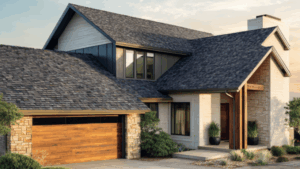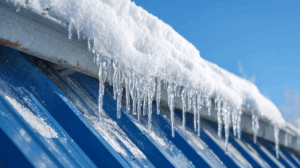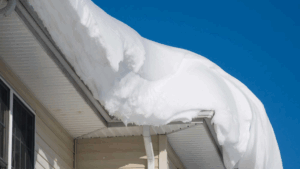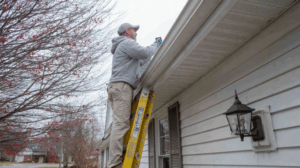In many Dayton neighborhoods — from the historic streets of South Park to the quiet, tree-lined avenues of Oakwood — mature trees are a big part of what makes a property feel like home. But when limbs hang too close, leaves pile up in your gutters, or you’re dealing with shade and moss growth, you might start asking: Do I have to cut the tree down going over the roof? Or worse — Can tree branches damage a roof?
These are common concerns for homeowners who care about their landscaping and their home’s long-term integrity. Fortunately, you don’t have to choose one or the other — but you do need the right roofing system.
At Cornett Roofing Systems, we’ve helped hundreds of homeowners across Dayton and the Midwest find solutions that protect their roofs and preserve the landscape they love.
What You’ll Learn:
- When a tree becomes a problem (and when it doesn’t)
- What materials stand up best to leaves, limbs, and shade
- How trees affect roof performance, warranties, and costs
- Which roof is right for tree-heavy lots in Dayton, OH
Need help now? Schedule your free inspection and let us evaluate your tree coverage, roofing material, and long-term options.
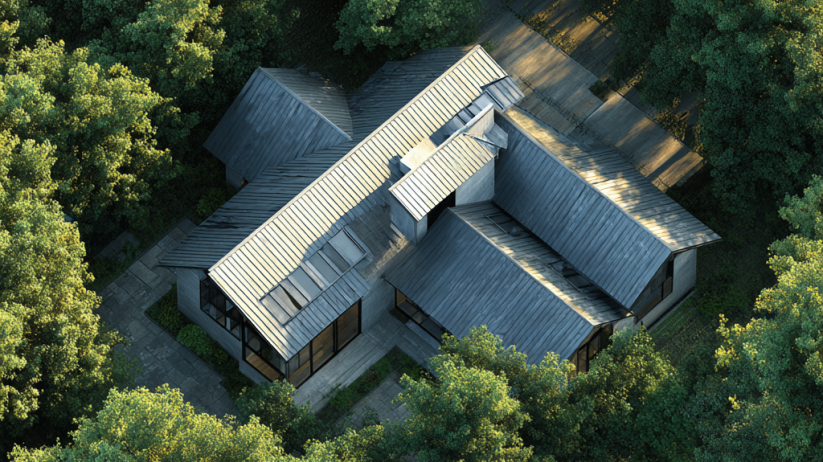
Why Tree Canopy Impacts Roof Lifespan in Dayton’s Climate
Here in Dayton, we experience four full seasons — and each one affects your roof differently. Add trees on roofs into the mix, and the stakes get higher. Rain, ice, wind, and extreme humidity create ideal conditions for moss, algae, clogged gutters, and premature wear — especially if overhanging limbs are brushing against shingles or depositing leaves directly onto the rooftop.
Common Tree-Related Roofing Problems We See:
- Gutter overflow from fall leaf buildup
- Shingle granule loss from limb abrasion in windy weather
- Persistent shade creating damp spots that foster moss or mold
- Structural damage from falling limbs after ice or windstorms
If you’ve been wondering, “Can tree branches damage a roof?”, the answer is yes — especially when you factor in Dayton’s seasonal extremes and the heavy rainfall we see in spring and fall.
What Homeowners Should Consider Before Choosing a Roof for Tree-Covered Homes
Not every roofing material is created equal — and not every tree needs to go. Before replacing your roof or calling a tree removal company, consider these key questions:
| Planning Factor | Why It Matters |
| Branch proximity | Branches should clear the roof by at least 3 feet |
| Leaf and debris volume | Heavy drop zones require more maintenance and impact-resistant materials |
| Shade vs. sun exposure | Shaded roofs dry slower and are prone to moss/algae |
| Current roof condition | Moisture issues or surface damage can escalate under tree cover |
| How long you plan to stay | If this is your forever home, choose a permanent solution that lasts |
The Best Roofing Materials for Tree-Covered Homes in Dayton
Choosing the right roofing system comes down to durability, low maintenance, and how well it can handle the demands of a shaded or debris-prone environment.
Standing Seam Metal Roofing
This is hands-down the most tree-friendly roofing system we install.
Why it’s ideal for tree coverage:
- Smooth surface makes it easier for leaves and branches to slide off
- Won’t grow moss or algae like rougher materials
- Excellent impact resistance against falling limbs
- High uplift resistance during storms
- Minimal maintenance, even under heavy canopy
Bonus: At Cornett Roofing Systems, we manufacture our own metal panels — giving you full control over color, fit, and finish. If you want durability with clean lines and long-term protection, this is your best bet.
If you’re still comparing your options, we also recommend reading The Best Roofing Material for Midwest Homes & Offices. It breaks down how Midwest weather — including wind and seasonal debris — should influence your roofing decision.
Synthetic Slate or Tile
If you’re in a historic neighborhood or want a high-end look without the weight of natural stone, synthetic slate is a smart alternative.
Why it works:
- Durable and impact-resistant
- Doesn’t crack under limb impact like natural tile
- Lighter weight is better for older homes
- Minimal moisture absorption
Architectural Asphalt Shingles
Still widely used — but not the best fit under tree cover.
What to know:
- Affordable upfront
- Prone to moss growth in shaded areas
- Loses granules quickly under limb contact
- Needs regular gutter cleaning and surface checks
This option might work for temporary roofs or flips, but if you’re staying long-term, you’ll want to upgrade before trees take their toll.
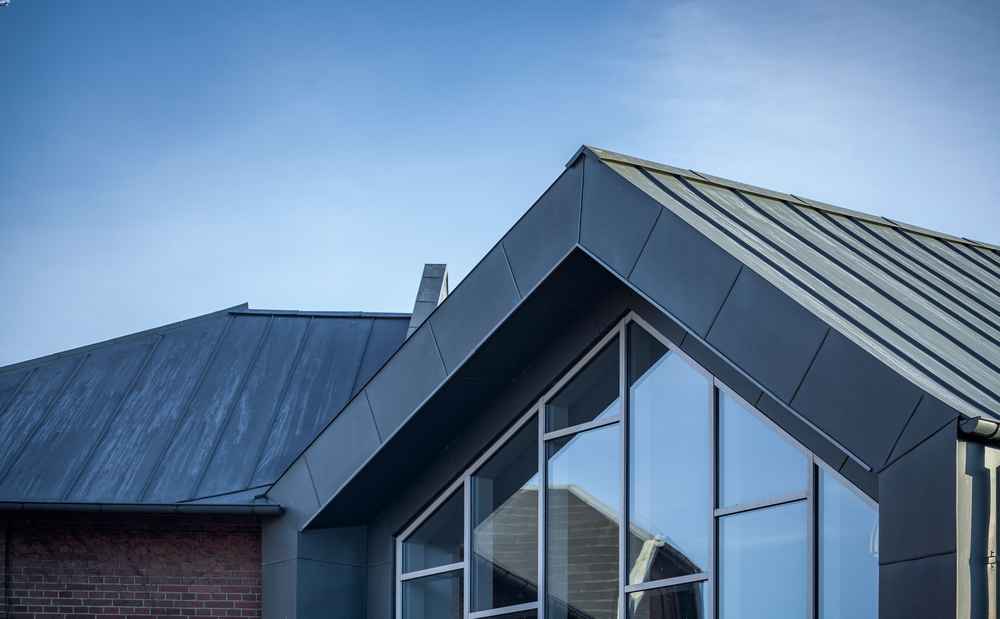
How Cornett Roofing Systems Protects Homes with Heavy Tree Coverage
After 30+ years in the Midwest roofing business, we know what works and what fails — especially under tree-heavy lots. Here’s what we bring to the table:
- In-house manufacturing of metal and synthetic products
- Customized trim and edge protection to manage leaf and water runoff
- Drone inspections that reveal early signs of moisture damage or abrasion
- Long-term warranties — even under tough conditions
- Experience with historic homes and tree-heavy lots throughout Dayton
If your current roof is showing signs of stress, or you’re trying to build a roofing plan that accounts for trees without losing sleep, we’ve got you covered.
Dayton Roofing FAQs: Trees and Roofing Material Questions Answered
Do I have to cut a tree down going over the roof?
You do not always have to cut a tree down going over the roof. In many cases, pruning or crown lifting is enough to prevent damage while preserving the tree.
Can tree branches damage a roof?
Yes, tree branches can damage a roof. They may scrape shingles, dislodge flashing, trap moisture, or fall and cause impact damage — especially during storms.
Are trees on roofs or close to rooftops dangerous?
Trees on roofs or close to rooftops can be dangerous if left unmaintained. Proximity increases risk for abrasion, clogging, and even structural damage during ice or wind events.
What is the best roofing material for tree-covered homes?
The best roofing material for tree-covered homes is standing seam metal or synthetic slate. These materials resist moss growth, limb impact, and moisture damage better than asphalt.
How far should tree branches be from the roof?
Tree branches should be trimmed at least 3 feet away from your roof’s surface. This allows wind movement without contact and helps keep your roof drier and cleaner.
Can Cornett Roofing Systems help with both the roofing and tree assessment?
Yes, Cornett Roofing Systems can inspect your roof and assess how tree coverage may be affecting its performance. We’ll provide a clear plan for trimming and material options that work with your environment.
Final Thoughts: Trees Are an Asset — But Your Roof Still Needs to Be Ready
You don’t have to choose between your trees and your roof. You just have to build smarter — and that starts with the right roofing material.
At Cornett Roofing Systems, we specialize in permanent roofing solutions for Midwest homes — especially those with challenging tree cover. Whether you’re looking to preserve your lot’s beauty, avoid frequent repairs, or simply protect your investment, we can help you make the right call.
Schedule your free inspection today, and let’s talk about how to make your roof and your trees work together — not against each other.

